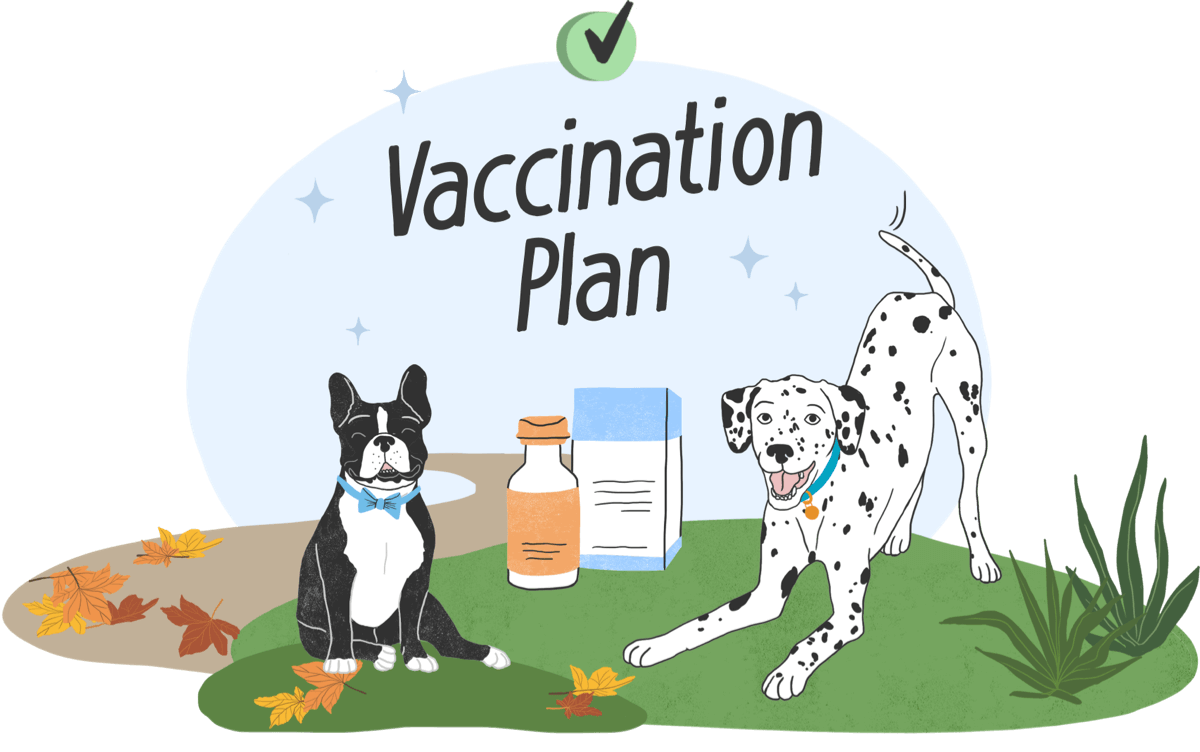Canine distemper is a serious but preventable virus that attacks the respiratory, gastrointestinal, and nervous system. The virus has a long history, with 900 dog deaths recorded on a single day in 1760 in Madrid, Spain.1
We have a canine distemper vaccine to help keep our dogs healthy, but puppies younger than four months old and dogs that aren’t fully vaccinated are at the highest risk of catching the virus.
Effects of Canine Distemper Virus
When a dog is infected, the virus spreads quickly throughout their entire body. Distemper dramatically weakens a dog’s immune system, making them susceptible to secondary infections. A dog's skin, respiratory tract, gastrointestinal tract, and central nervous system can all be severely affected, often leading to death or euthanasia due to high risk of transmission to other dogs, risk of potential long-term illness, and high fatality rate.
The term ‘distemper’ might make you think of grouchy or ill-tempered dogs, but that’s not why it’s the name of of this disease.
Is Distemper Contagious?
Canine distemper is highly contagious. Dogs are considered the reservoir host for the disease,2meaning the virus lives and thrives in dogs, and they serve as the main source of infection to other susceptible animals, like foxes, wolves, skunks, and raccoons.
It spreads through direct contact between a susceptible dog and an infected dog, or a susceptible dog that comes into contact with an infected dog’s fluids, like saliva, urine, or feces. Over short distances, the virus can be spread through the air when dogs cough, sneeze, or bark.
An infected mother dog can pass the virus to her unborn puppies.
The virus spreads most readily in areas with a low vaccination rate and a large population of unvaccinated dogs. A dog infected with distemper can be contagious to other dogs before showing any clinical signs. Those signs start anywhere from three days to six weeks following infection.3
Once infected, a dog can remain contagious for several months.
Signs of Canine Distemper
Clinical signs can vary and will depend on the age of your dog, vaccine status, your dog's overall health, the viral strain they have, and the degree of exposure.
Unfortunately, the most common signs of canine distemper are similar to many other diseases that may or may not be less risky. These signs include:
- Fever
- Thick, yellow discharge from the eyes or nose
- Coughing
- Lethargy
- Vomiting
- Diarrhea
- Poor appetite
- Thickening or crusting on the nose or paw pads
If a dog is suffering from a severe case of distemper, they may also show neurologic signs, which can include:
- Abnormal gait or movement
- Muscle twitching, especially in the face
- Head tilt
- Circling
- Paralysis
- Seizures
How Canine Distemper Is Diagnosed
The clinical signs of canine distemper virus mimic those of other common diseases, making the initial diagnosis difficult, and often leads to increased spread of the disease between dogs and/or delays in treatment.
To determine which diagnostic tests your dog needs, your veterinarian will have to get a detailed medical history and perform a physical examination.
There are a few diagnostic tests your veterinarian may recommend determining if your dog has canine distemper virus:
- PCR test used to determine if the virus's genetic material is present
- Blood sample collection to test for distemper antibody levels
Since a dog infected with distemper virus becomes at higher risk of contracting other infections, your veterinarian will also recommend diagnostic tests to check for other diseases. Testing may include:
- Bloodwork
- Chest radiographs (X-rays)
- Cytology or histopathology of affected tissue
- Eye examination
- Cerebral spinal fluid analysis
Treatment for Canine Distemper
Like many diseases caused by a virus, there isn’t a specific treatment for canine distemper virus.
The mainstay of treatment is supportive care to manage discomfort, address any secondary infections, and similar efforts to try to keep things from worsening. However, all too often due to disease severity and/or risk of transmission, many veterinarians recommend euthanasia, even upon diagnosis. This care may include:
- Costley intensive care quarantine hospitalization
- Intravenous fluids
- Antibiotics
- Medications to control pain, nausea, vomiting, diarrhea, cough, and seizures
- Intravenous nutrition
Even with treatment, some dogs do not recover. Dogs with neurologic signs like seizures and paralysis have a poorer prognosis with about a 50% death rate4, with an even higher risk of death in puppies.
Following recovery, some dogs will have long-term or permanent neurologic damage such as muscle twitches or seizures.
How To Help Prevent Canine Distemper
Vaccination is the easiest and most effective way to help prevent canine distemper virus. It is recommended as one of the core vaccinations for your dog. It's a series of vaccines initially given to puppies starting at six to eight weeks of age and repeated every three to four weeks until the puppy reaches sixteen to twenty weeks. The vaccine should be given a year later and every three years after that in order to maintain the vaccine's efficacy.
For older dogs (dogs over a few months old) with an unknown vaccine history, the vaccine should be given as a series of two vaccines three to four weeks apart. Then, a booster vaccine is given a year later and every three years after that.
Dogs should be isolated from high-risk areas, such as dog parks, pet shops, groomers, etc. until they have completed the vaccine series.
Canine distemper virus on contaminated surfaces is easily killed by common disinfectants. Therefore, sanitation is essential in any area an infected dog inhabits. Anyone caring for an infected dog should wash their hands and remove any clothing before contact with other dogs.
ZPC-04419
- Origins of Canine Distemper Virus: Consolidating Evidence to Understand Potential Zoonoses. National Library of Medicine. https://www.ncbi.nlm.nih.gov/pmc/articles/PMC6722215/. Accessed February 23, 2024.
- Canine Distemper. Merck Manual. https://www.merckvetmanual.com/generalized-conditions/canine-distemper/canine-distemper. Accessed February 23, 2024.
- Canine Distemper Virus. Cornell University College of Veterinary Medicine. https://www.vet.cornell.edu/departments-centers-and-institutes/riney-canine-health-center/canine-health-information/canine-distemper-virus. Accessed June 12, 2025.
- Distemper in Dogs. Veterinary Partner. https://veterinarypartner.vin.com/default.aspx?pid=19239&id=11692001. Accessed February 23, 2024.



